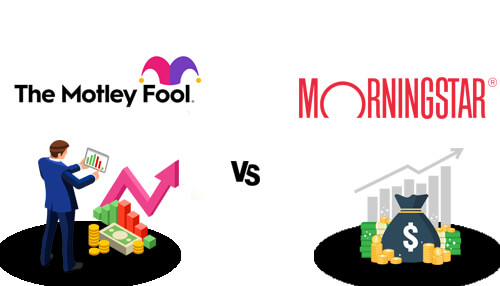The past few years have seen a boom in retail trading because of two seismic shifts in the financial world: easy-to-use, commission-free brokerage options and a glut of easily accessible information. There are many options for the former, like Robinhood and tastytrade, but even the leading players (TD Ameritrade, Charles Schwab) have acquiesced to the cheap or free trading platform model. These resources, such as Motley Fool vs. Morningstar, are very important in treading the latter and allow investors to compare strategies.
The latter is a little more complicated. Sure, Reddit’s WallStreetBets had a few big hits, but the now-choppy economy obliterated many of the gains made during the pandemic stock surge.
Where can we go for reliable, accurate, and timely investing information?
Enter: Motley Fool and Morningstar.
You’ve probably seen references to both across the Internet, as both are dominant players in the subscription-based investing information sphere. But which is better for the average trader or investor seeking to:
1. Understand what equities to buy and the why behind the purchase.
2. Maximize returns, especially in the economic storm that’s increasingly difficult to navigate.
3. Gain financial freedom and independence.
Let’s look at what each service offers.
Morningstar
Morningstar is one of the oldest services of its type, and its longevity is due to its excellent track record in helping investors better understand the nuances and depths of the investing landscape. Morningstar sets itself apart in two ways:
1. Analytics and a data-driven research approach.
2. A focus on lower-risk, tried and true investing strategies.
The Depths of Morningstar’s Data
Simply put, Morningstar’s proprietary, algorithmic approach coupled with qualitative analysis from over 150 independent and unbiased industry experts means that the information you’re using to inform your investments is vetted, reliable, and accurate.
To make it even easier, Morningstar uses a system of stars and gold/silver/bronze legends to make it easy to see what’s worth investing in immediately.
For the more sophisticated investor or someone interested in the quantitative method behind the madness, Morningstar’s services offer a complete look behind the curtain at the past performance and prospects of all their assessed conclusions.
Even better, their quantitative and method-based analytic strategy results in an investing strategy that enables maximizing risk-adjusted returns. What does this mean? Let’s take a look.
Strategic Stability
Morningstar focuses on the pillars of traditional investing: individual stocks, mutual funds, and ETFs. Through Morningstar’s unique screening tools, you can determine your risk profile and tolerance, then build a basket of diversified and risk-adjusted investment equities.
1. A diversified portfolio, or one in which the individual selections are as non-correlated as possible, means that your capital is protected in the event of a downturn in one sector.
2. Risk-Adjusted Returns. A cornerstone of modern portfolio theory, risk-adjusted returns mean that the investor, using analytic tools like those provided by Morningstar, calculates the specific risk associated with an investment and determines whether the projected return is worth the risk assumed. Sound complicated? It is. But Morningstar’s foundational quantitative analysis makes the comprehensive calculating more manageable, even though some nuances may be lost on a newer investor.
Downsides
Access to vast troves of information while enabling a safe and stable investing strategy is the dream of most investors looking forwards to a future of financial freedom. What, then, are the downsides to Morningstar?
1. Morningstar is expensive, at an annual expense of $249 (although you can get a great deal as a new subscriber – check out the link at the bottom of this article).
2. Expertise and Engagement. The biggest draw is also the biggest drawback. The sheer amount of fantastic information can overwhelm a newer trader and cause an analysis by paralysis – confronted with so many options and so much detail, the newer trader freezes and doesn’t know how to proceed. Additionally, so much data requires that the user is active in managing their investment portfolio, so it benefits those with both the inclination to do so and the total capital to enable active investing.
Motley Fool
Slightly younger than Morningstar, Motley Fool has recently become a breakout favorite amongst new retail traders and investors. This is mainly due to their prescriptive stock-picking nature and more significant risk tolerance resulting in potentially much higher returns.
Portfolio Prescription
Motley Fool’s flagship service, Stock Advisor, provides specific stock picks that they see as viable candidates for holding (with that being said, the baseline Motley Fool philosophy is that the investor has a basket of ~25 diversified individual stocks they are comfortable holding for at least five years irrespective of individual stock volatility).
This prescriptive nature is fantastic for the newer investor who may feel overwhelmed by having to do their due diligence and wants an opportunity to get access to direct expert recommendations. Instead of a dry assessment and drawing your conclusion, Motley Fool subscribers can see precisely what those in the know are picking, buying, and holding.
Motley Fool has expanded its offerings to include Rule Breakers, focusing on high-growth, potential 10x stocks. This, alongside their real estate and retirement advising offerings, make Motley Fool a one-stop shop for anyone starting or well along their investing journey.
More Risk, More Reward
If Morningstar’s emphasis on broad-market and risk-adjusted return investments trends towards the overall lower risk side of the bell curve, Motley Fool’s focus on individual stock selection makes it slightly higher risk by default. This is great for the younger investor who is investing on a much longer time horizon than older investors close to retirement. And while the Motley Fool Stock Advisor’s picks have outperformed the broad market on a time-weighted return basis, we do seem to be entering a new economic period markedly different from the past ten years, where an increased cost of capital may cause a cyclical rotation out of the high-risk/high-reward equities that Motley Fool prizes.
They may be able to adjust and orient themselves, but this is an additional risk factor a potential subscriber needs to consider.
Downsides
The additional assumption of risk inherent in Motley Fool’s strategy (albeit for higher potential returns) aside, what other downsides does Motley Fool have for a retail investor?
1. Much like Morningstar, Motley Fool isn’t free and clocks in at an annual $199 for the flagship, baseline Stock Advisor service with additional add-ons available for more money. Luckily, though, we also offer a steep discount for new users.
2. Motley Fool’s marketing campaigns are aggressive even after subscribing to their baseline service. It’s our bias, but it is a turnoff to see multiple upsell emails daily from a service you pay for. You can turn this off in the site’s settings, but it did leave a bad taste in our mouths.
The Bottom Line
Each service offers a unique, goal and investing strategy-oriented service.
Motley Fool’s riskier but prescriptive service is excellent for novice investors who want to be told exactly where to deploy their capital as they learn the ins and outs of the market and investing.
Morningstar’s depth and breadth of information are perfect for digging into the details and knowing the why behind the what and how of your investing – but that does require more time and attention than Motley Fool’s services.
Overall, we think Morningstar is a better pick – more expensive in both subscription and time capital, yes, but the investment of both will reap dividends as you continue your investing journey.
Want to know more before you pull the trigger? Here’s our full head-to-head breakdown of Motley Fool vs. Morningstar.
Already know which you prefer?
Click here for our special introductory Morningstar discount or here for our exclusive Motley Fool unlimited access Stock Advisor pricing.




